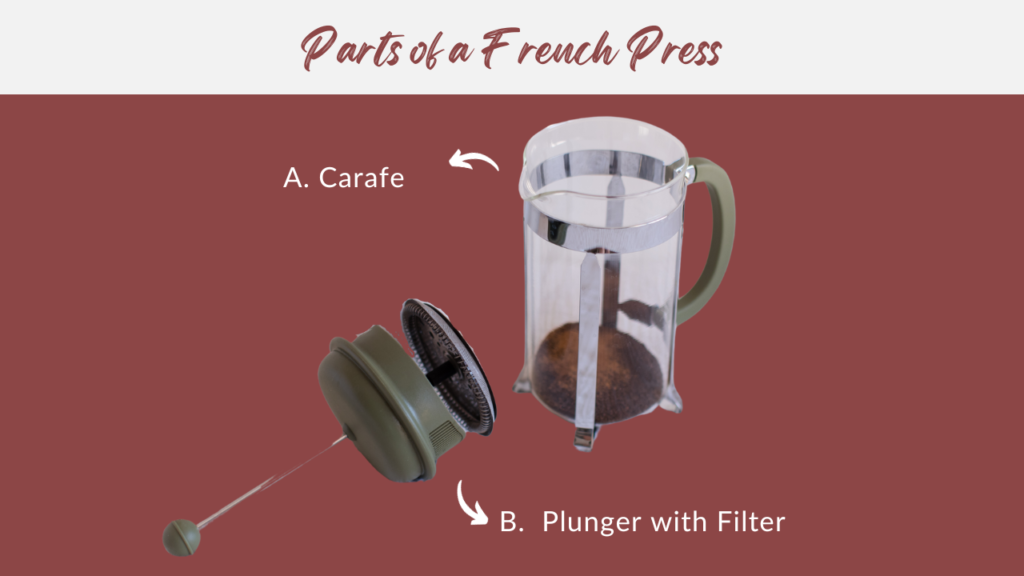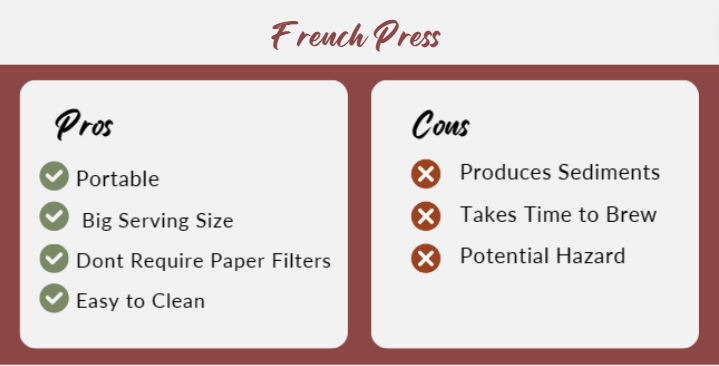The battle of Moka Pot vs. French Press is never-ending among long-time coffee lovers. Indeed, both techniques have their unique characteristics, and each with its own set of trade-offs.
In this article, I will indulge you with a transparent and unbiased comparison between Moka Pot and French Press. This way, you’ll have a better understanding as to which technique is better for you.
Table of Contents
Before we dive into this, let’s briefly review these two methods.
What is a Moka Pot?

Simply, a Moka Pot is an hourglass-shaped stove-top coffee maker that brews strong coffee. It consists of three inner compartments:
A. Bottom Water Chamber: where water is added
B. Middle Basket and Filter: to hold the coffee grounds
C. Top Coffee Chamber: a place to collect brewed coffee.
The Italian inventor Luigi Di Ponti designed it this way to cater to a specific mechanism called pressurized brewing, using pressure to push up and allow water vapor to pass through the ground beans and extract coffee flavors.
Because of the pressurized water, moka pot coffee is strong and has a slightly smoky aftertaste. To make it, a 1:10 coffee-to-water ratio is usually followed, resulting in a robust coffee that is a bit similar to espresso.
In modern times, a moka pot can come in a variety of colors and sizes. Some are made of aluminum, and others are made of stainless steel. However, the authentic version of the moka pot is still being produced by the Bialetti Company ever since Di Ponti sold its patent to the renowned Alfonso Bialetti.
Fun Fact: Moka Pot was named after the city of Mocha in Yemen.
Moka Pot: Pros and Cons

If you like strong coffee, a moka pot is a good option. Not only does it produce intense and robust coffee, but it’s also a lot more budget-friendly than having an espresso machine. Unlike other coffee gears, it has a built-in filter, so you wouldn’t need to worry about running out.
However, using a moka pot can be inconvenient because it requires a stove and constant attention to avoid over-extraction. The brewing time varies significantly depending on the heat of your stove. Plus, using a moka pot can be a potential hazard. The hot steam can injure you if you don’t stay alarmed.
For more moka pot brewing guides, check our article on how to brew coffee.
What is a French Press?

A French press or a cafetiere is a cylindrical coffee brewer that is often made of glass. It also comes with a plunger that has a metal filter attached below. As the name “French Press” suggests, you have to press down the plunger to force the coffee grounds to the bottom of the carafe, leaving the brewed coffee on top.
Since its invention in 1852 by French men Mayer and Delforge, many have found that a 1:15 coffee-to-water ratio creates a more balanced brew, not over- or under-extracted. A classic French Press Coffee, the flavor is full-bodied and aromatic, yet it has a smooth mouthfeel.
A French press comes in many sizes, but the standard one is about 500 ml. Now, you can buy a French Press made of stainless steel. However, many would still prefer one that is made of glass as it does not impart any taste to the coffee, unlike stainless steel.
Pros and Cons of French Press

If your tastebuds love a smooth coffee with full-bodied and more complex flavors, then having a French Press is the absolute deal. While some claim this equipment is difficult to clean, especially unclogging the filter, we found it effortless, especially if you soak it in hot water for some time.
French Presses typically use a metal mesh filter. Although this is what gives the coffee a more full-bodied flavor, it is also the cause of inevitable grainy sediments in your coffee. Most French presses are made of glass. It can be dangerous if you unexpectedly break it.
Moreover, compared to other brewing methods, a French press can take a bit longer to brew. If you’re often rushing, this can be a slight inconvenience for you.
For more French press brewing guides, check our article on how to make French press coffee.
Moka Pot vs. French Press: An Overview
The chart below is a general comparison between moka pot and French press.

Difference in Brewing Technique
The most significant difference between a moka pot and a French press is they use distinct brewing mechanisms. Arising this aspect, they also differ in brewing time, coffee-to-water ratio, and grind size.
Brewing Mechanism and Coffee-to-Water Ratio
Moka Pot: Percolation (Pressurized Brewing) and a ratio of 1:10
French Press: Infusion Brewing and a ratio of 1:17
As mentioned earlier, moka pot uses a mechanism called pressurized brewing, which is one method of Percolation. Percolation is a fancy term that describes the process of letting water pass through a bed of ground coffee to extract all the oils and aromas from it.
On the other hand, the French press uses the Infusion method of coffee brewing. Infusion is the process of steeping the coffee grounds in water to extract oils and flavor for a certain period of time.
To brew a cup of coffee, a moka pot also needs less water than a French Press for the same amount of beans. This is because steam pressure is more efficient at extracting coffee than immersion.
What to know more? Check out our article on How to brew coffee.
Moka Pot vs French Press: Grind size
Moka Pot: Finely ground beans
French Press: Coarsely ground beans
Moka Pot requires finer grounded coffee beans than a French Press because it allows the exposure of more surface area for hot water to be in contact with. This is necessary for a faster extraction time.
By contrast, coarse ground beans are paired with a French Press because of the longer steeping time. This helps prevent over-extraction and bitterness.
More information can be found in these articles: How Fine to Grind Coffee and Master the Perfect Coffee to Water Ratio.
Which Brews Faster? Moka Pot or French Press?
Moka Pot: Finely ground beans
French Press: Coarsely ground beans
French press coffee takes longer to brew than a moka pot coffee, mainly due to the difference in the extraction rate.
French press has a slower extraction rate because it uses the infusion method. To avoid damaging coffee grounds and over-extraction, we use a water temperature that is below boiling point. Moreover, as we let the grounds steep, the water temperature may drop, consequently affecting the length of immersion for full saturation and flavor extraction.
On the other hand, a moka pot brews faster because it uses steam pressure to continuously force hot water through the grounds. This continuous flow of water helps to keep the extraction temperature consistent, resulting in a quicker brewing process.
Moka Pot vs French Press Taste
Moka pot and French press coffee both produce strong and flavorful cups of coffee but with varying flavor profiles.
Moka pot coffee is usually more robust and concentrated than French press coffee. It also has a syrupy-like mouthfeel that French press coffee does not possess. Often, it is compared to an espresso, but it doesn’t really match an espresso’s strength or bitterness.
Although rich and full-bodied, a cup of French press coffee has a smooth mouthfeel and is known for its complex flavor profile. Because of the coarser grind size and the longer brewing, a French press coffee is also less acidic than a moka pot coffee.
For recommendation, if you prefer a robust and acidic flavor with a full-mouth feel, invest in a moka pot. If you want your coffee with a brighter feel, brew your coffee with a French press.
Is there a Difference in the Serving Size?
Moka Pot: 2 oz
French Press: 12 oz
The traditional serving for a cup of Moka pot coffee is about 2 oz or 60 mL. Now, moka pots come in a variety of sizes, so you can serve up to 12 people by using a 12-cup moka pot.
A standard French press can produce 12 oz or 360 mL of coffee, which is six times more than a 1-cup Moka pot. If you’re planning to have friends over, it isn’t such a bad choice as the largest French press can brew up to 51 oz or 1.5 Liters of coffee.
Gear Usage
Skills
Winner: French Press
Although it may seem that both equipment are straightforward to use, a moka pot requires more practice and skills.
You have a few factors to consider to make a good cup of moka pot coffee. Stove heat control plays a big part in how your coffee is going to turn out. Too much heat can lead to bitter coffee, while not enough heat can cause it to be bland and under-extracted.
In contrast, the French press can brew a more consistent tasting coffee as it is very beginner-friendly. After experimenting with what beans, grind size, coffee-to-water ratio, water temperature, and steeping time work for you, just simply rinse and repeat the process!
Convenience and Cleaning
Winner: French Press
Clearly, a moka pot isn’t very convenient as it lacks portability. With a stovetop Moka pot, you’ll always have to rely on a stove to make your gear work. And although there are now electric moka pots, you are still tied to a power source.
Moreover, a moka pot is more difficult to clean than a French press because it has more areas and crevices that are fairly difficult to access.
On the other hand, a French press is much more convenient as you can even take it camping! It is also easier to clean due to its relatively more uncomplicated structure. There are no dead angles inside, and the coffee grounds left in the metal filter can also be washed off directly by water.
Which is Better: French Press or Moka Pot?
If you’re looking for a portable and easy-to-use coffee gear that produces a rich yet smooth textured coffee, French press is better. But, if hassle isn’t a problem and you want an intense, heavy-bodied, and more acidic cup of coffee, a moka pot is a great choice.
I hope you enjoyed this article. If you’d like to know more, let me know in the comments!
Watch How to Make French Press Coffee here!

